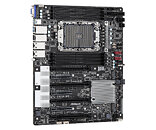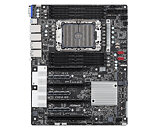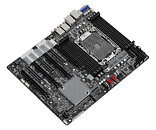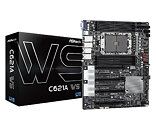Thursday, July 29th 2021

ASRock Launches C621A WS for Server and Workstation Application
The leading global motherboard, manufacturer, ASRock, is proud to announce its Intel C621A powered workstation motherboards, the C621A WS, this motherboard is able to pair with the latest Xeon W-3300 processors, giving ultimate performance for almost every application such as content creating, rendering machine and high-end workstation.
The ASRock C621A WS is a platform solely built for workstation application from ground up, the 4 PCIe 4.0 x16, 3 PCIe 4.0 x8 on this motherboard supports up to 4 dual-slot GPU/FPGA cards, perfect for Deep learning workstation, Visual computing such as 3D design and creation. The motherboard has 8 DIMM slots running at 1 DIMM per channel mode giving ultimate stability and performance, supporting DDR4 RDIMM, LRDIMM, and Intel Optane Persistent Memory in order to maximize the system capability.Internet connectivity is also a highlight on ASRock C621A WS, this motherboard is geared with 2xRJ45 with 10 GbE by Intel Intel X710-AT2 controller, and besides the 10 GbE connectivity, it also has 2*RJ45 (1 GbE) by Intel i210 for maximum internet excess, offering fast and vast option for media center, workstation and General purpose server.
To speed up the connection from outside the system, this motherboard also has 2x USB 3.2 Gen2 Type-C header for front panel connections, the speed and reversible design makes upload and downloading large size file a ease. And besides the vast connectivity of this motherboard, the C621A WS also supports remote management through IPMI interface, giving system administrators out-of-band managing and monitoring capability of computer systems.
For more information, visit this page.
The ASRock C621A WS is a platform solely built for workstation application from ground up, the 4 PCIe 4.0 x16, 3 PCIe 4.0 x8 on this motherboard supports up to 4 dual-slot GPU/FPGA cards, perfect for Deep learning workstation, Visual computing such as 3D design and creation. The motherboard has 8 DIMM slots running at 1 DIMM per channel mode giving ultimate stability and performance, supporting DDR4 RDIMM, LRDIMM, and Intel Optane Persistent Memory in order to maximize the system capability.Internet connectivity is also a highlight on ASRock C621A WS, this motherboard is geared with 2xRJ45 with 10 GbE by Intel Intel X710-AT2 controller, and besides the 10 GbE connectivity, it also has 2*RJ45 (1 GbE) by Intel i210 for maximum internet excess, offering fast and vast option for media center, workstation and General purpose server.
To speed up the connection from outside the system, this motherboard also has 2x USB 3.2 Gen2 Type-C header for front panel connections, the speed and reversible design makes upload and downloading large size file a ease. And besides the vast connectivity of this motherboard, the C621A WS also supports remote management through IPMI interface, giving system administrators out-of-band managing and monitoring capability of computer systems.
For more information, visit this page.




7 Comments on ASRock Launches C621A WS for Server and Workstation Application
But unfortunately they put the CPU socked in the "wrong" orientation. This orientations is usually used in server boards which are designed for racks, while workstation boards usually have the socket rotated 90 degrees to fit normal tower coolers (pulling air front to back in a normal case).
I'm not convinced about ASRock's quality, so when I build an expensive workstation I stick to Asus and Supermicro.
Here is an even more exciting board from Supermicro: X12SPA-TF.
Unfortunately that also means the middle screw hole is absent at the top of the board, seems like this board should probably have all its DIMMs and connectors plugged in outside the case first.
This Motherboard will be fine in any "normal" Case that has top mount ventilation, which is a large number of Cases on the market.
Rear ventilation is usually one 120mm fan, while top ventilation is generally 3 x 120mm fans.
Those top fanmounts are primarily intended for radiators, which is something that doesn't belong in a workstation.
Just putting three fans at the top runs the risk of the fans pulling cool air out of the case, as much of the air will bypass the CPU cooler. Plus if you have a large graphics card, it needs to be spaced further away from the CPU, but even then the CPU cooler will be starved for cool air.
Most decent cases for workstations (like Fractal Design 7/7XL, BeQuiet Dark Base 900, etc.) will have substantial better airflow front to back than bottom to top. With 2-3 good intake fans and one exhaust fan at a little higher speed (causing positive pressure), cooling a 270W CPU and a ~250W GPU will be easy while retaining low noise levels.
Random aside, server and workstation boards look so BA in comparison to the superficial garbage going on with all the "gamer" boards.